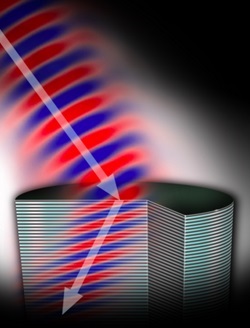04/07/2016
LAWRENCE — The Air Force Office of Scientific Research has awarded a three- to five-year grant to University of Kansas researcher Alessandro Salandrino, assistant professor of electrical engineering and computer science.
The award of $120,000 each year via the Air Force’s Young Investigator Research Program will enable Salandrino to explore “time-varying metamaterials.”
Metamaterials are engineered to manipulate electromagnetic radiation — such as radio waves, microwaves, visible light or x-rays — with characteristic features that measure even smaller than the wavelengths of the electromagnetic radiation with which they interact.
“The subject of metamaterials in modern electromagnetism is very broad,” Salandrino said. “They are materials made of nanostructures that interact with electromagnetic fields in a way you can control — they interact with light in way you can design.”
He said metamaterials could have many uses, some of which clearly might benefit U.S. national defense. These include optics, aerospace design, sensors, solar panels, lenses and communication devices.
“There will be a variety of applications,” Salandrino said. “The whole field of metamaterials started with imaging applications, such as the ‘perfect lens,’ so imaging is definitely an important aspect. There will be ways to use metamaterials to reduce or enhance the visibility of an object, maybe a small object in a circuit or a larger thing — like an airplane.”
But he said the advance of metamaterials has been hampered by their tendency to absorb electromagnetic radiation due to the metals often used in their production.
“Metals are an important ingredient because they have very specific electromagnetic properties when mixed with other materials like glass and other materials,” Salandrino said.
He said if scientists could manage to solve the problem of absorption in metamaterials, many of the applications that have been dreamed up — but not realized — might become possible.
He gave the example of next-generation microscopes that could lead to breakthroughs in medical research.
“Like imaging for biology, there are several interesting proposals that because of the losses, or absorption, haven’t seen development,” Salandrino said. “This work could bring closer to reality ideas for applications that have been around for the past 20 years.”
Salandrino’s concept is that the absorption problem could be sidestepped if metamaterials could morph over time, in reaction to various inputs such as electron flow.
“Transformation optics is a very advanced theory for electromagnetic design, essentially using mathematical rules to modify properties to achieve imaging applications molding the flow of light,” he said.
By laying the theoretical groundwork for metamaterials that change with time, Salandrino thinks he can overcome the absorption problem and push forward the technology. His research will involve developing new theories based on a rigorous multidisciplinary literature review, coupled with experimentation using ultrafast lasers.
“We’re laying the foundations of a new chapter in applied electromagnetics,” Salandrino said. “We hope to develop new concepts in both optics and radiofrequency. We proceed by looking at current limitations and restrictions, and one by one, we try to remove them. We’ll try to shine light on paths to follow.”















